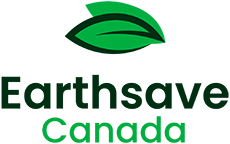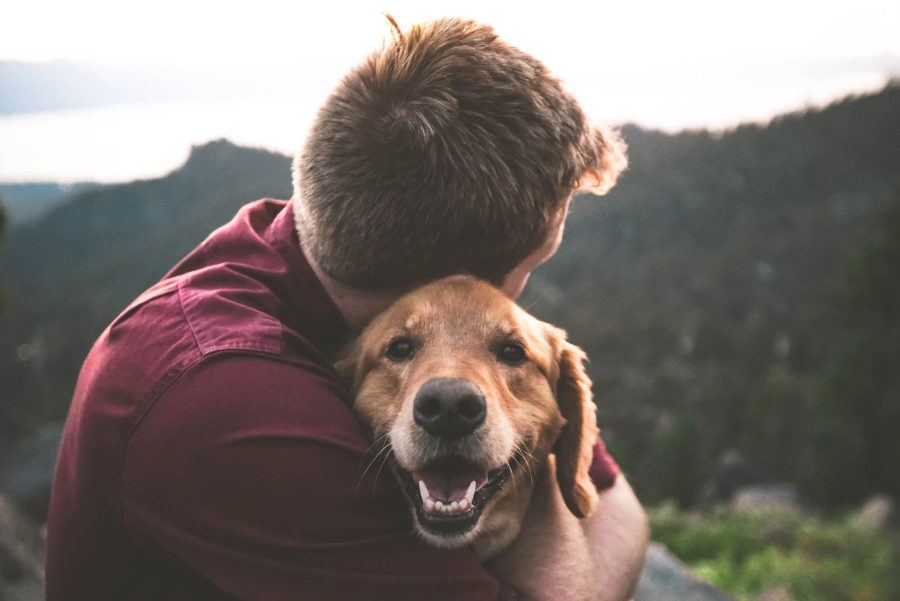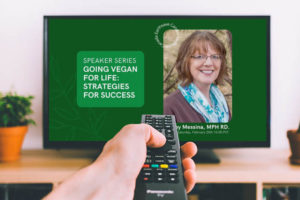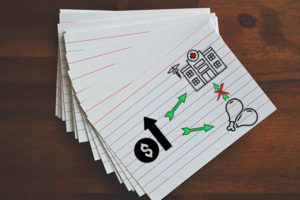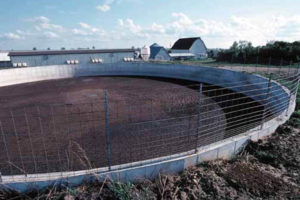This is a sermon delivered by Earthsave Canada president David Steele at the Unitarian Church of Vancouver, July 31st, 2016.
Six years ago today, on July 31st 2010, one of the closest friends I’ve ever known died. Her name was Tasty. Tasty the Sky. She was a canine person. An Australian Shepherd.
Tasty was born in early September 1993 in a research facility at the University of Virginia. She was bred to be deaf. It turns out that a common mutation in Australian Shepherds is an analog to similar mutations in humans – these mutations are behind the most common genetic cause of deafness in our species.
Once the study of her deafness was done, she was sent to another lab where the nerves to her heart were cut. The idea was to mimic one of the effects of a heart transplant. Her heart rate from then on was very low. Didn’t interfere with her health overall, though.
But the next event planned for her very definitely would have. Because she was no longer of any use to the institution, she was slated to be killed. Fortunately for her – and, as it turned out, for me – a brave veterinary student couldn’t let that happen. She spirited Tasty out of that place. After a short chain of events, Tasty found her new home with me.
I tell you about this because I think that it is through our pets that we often get insight into the internal lives of animals. We can learn from them how similar they often are to us – in their basic wants and desires; in their curiosity; in their problem solving, even.
Tasty would hug people she loved. She would remember how to navigate complex paths in places she once lived – years before – to find old friends or to get a treat that she expected would be at the end of the line. She was very bright. There’s no doubt about it. But really, she was unexceptional. The vast majority of creatures on this planet have amazing capabilities.
That’s in very large measure because, like you and me, they share a very basic and mysterious trait. They are conscious.
And wow is consciousness amazing!
To me, consciousness is the essence of what it is to be a person. It is awareness, the ability to experience. We all know we’ve got it, but we don’t really understand what it is. Physicians assess it by simple test, ranking humans’ consciousness on a scale ranging from full alertness and responsiveness, through states of delirium, and all the way to what they consider a complete lack of consciousness, defined by a complete lack of responsiveness to painful stimulation. Still, this is just a practical definition. It doesn’t get to what consciousness really is.
It’s a question that has eluded the greatest of minds for millennia. Philosophers have puzzled over it and scientists, too, haven’t been able to figure it out. Some claim consciousness is an illusion. The vast majority of us would disagree with that, I think – and with good reason. I include myself on that one. But still, try and tell me just what it is.
Some say that mind and body are separate; others say mind and body are the same. “Consciousness is a fundamental property of the universe”; “it’s a side-effect of how our brains are organized”; “it works like a machine”; “it works because of the spooky properties of quantum mechanics.” The list goes on and on. Put the theories together and what do you get? An unintelligible mess that still doesn’t explain what consciousness is.
Me, even though I don’t understand it, I think it’s physically based. We know that we can modify it by drugs – even eliminate it, e.g., for surgery, then bring it back at will. It disappears every night, too, as we sleep. That, to me, says that it arises as a property of our brains.
And again, looking around, as my experience with Tasty showed me so very well, we humans are obviously not the only creatures on this planet who experience it.
Dogs and cats, cows and pigs, chickens and crows all clearly share the basic experience of life that we do. Fish, too, show clear signs of conscious awareness. Charles Darwin saw it even in the lowly earthworm. I’m not so sure that he was right about that, but I do know that they can be trained to solve very simple mazes. Fruit flies are much better at solving mazes, though; and they can even learn from each other.
We humans have our biases, so most of what we know about animal consciousness comes either from tests of animal intelligence or studies on a trait that is medically useful to humans: pain. We look into intelligence because we value that in others; we look into pain mostly because we want to use the understanding we get from pain in animals to figure out how to alleviate pain in us.
On intelligence, know, for example, that orangutans are relative geniuses. They have been known to steal canoes and paddle them away and even to put on humans’ clothing, if given the chance. Returning to dogs for a second, we have good evidence they can recognize the emotions in other dogs’ faces and in our faces, too.
That animals feel pain is obvious.
We use rats in experiments on pain because we know that they will react to it like we do and that drugs that blunt pain in them almost always do the same in us. They recognize pain in each other as well, and will try to help when they see another rat in distress. Lots of studies have shown this! We’ve even learned that fish feel pain and react similarly to us when confronted with it.
Some scientists claim that fish are not actually feeling pain; their brains are too different from ours, they say. That, to me, speaks of irrational arrogance. One doesn’t need a similar brain to have fundamentally the same experience and ability. Different structures may well take on different roles in different species. Just look at the intelligence of a crow or a parrot! Or even a chicken!
Birds’ brains are very different from those of humans and other mammals. They lack the neocortex that so many scientists tell us is necessary for intelligence. Yet, they are clearly intelligent. Crows make tools – both in the lab and in the wild. Just last week, scientists reported observing New Caledonian crows make long hooks so that they could carry more than one item away from a scene at once. Clearly ‘bird brain’ doesn’t mean what we once thought it did!
I speak of this not only because consciousness is such an amazing mystery, but also because of its moral dimension.
Beings with consciousness feel joy and pain; excitement and disappointment. They have wants and desires. What we call good can befall them; so can ill.
In short, animals – like us! – have moral value. Jeremy Bentham captured it well in the first reading we heard today.
I am not saying that there are not differences in the ways that we and dogs and sharks and elephants experience consciousness. I’m not saying that the vast majority of other animals we share this earth with are anything like as aware as we are of their place in the world, or of the consequences of their actions.
What I am saying is that they are very much worthy of our moral consideration. That their experiences of life are sufficiently similar to our own that we should do our best to avoid causing harm to them.
We love our dogs and cats and do our very best to ensure that their lives are pleasant. Other animals are similarly deserving.
And those animals may be more aware of us and our abilities than you may think.
Many sure are aware that we are not beings to be trusted. We hunt them, pave over their habitats and otherwise disrupt their lives.
One study that I read about this week highlights this reality very well.
Scientists at the University of Western Ontario studied the fear responses of small predators. I confess that I haven’t read the study yet, so I don’t know the details. What I do know – reported in New Scientist Magazine – is that that badgers, foxes and raccoons evidently fear humans much more than they fear bears, wolves and dogs.
In one experiment, the scientists played badgers, in the wild, the sounds of bears, wolves, dogs and humans over hidden speakers. While hearing bears and dogs had some effect – reducing the likelihood that the badgers would feed, simply hearing the sound of people conversing or reading passages from books completely prevented the badgers from feeding.
A lot of animals, I would guess, if they think about it – think of we humans as terrible threats.
Clearly, from the animals’ points of view, we are perpetrators of horrors. We can’t say just how aware any specific animal is of the dangers we pose, but clearly they avoid us to the extent that they can.
There is one major way that we differ big time from at least the vast majority of the other animal species on earth. We have highly developed abstract language. We can learn from others over great distances; we can learn from ancestors long dead.
What a huge advantage that is!
And with that advantage comes great opportunity for improvement – and in my view, great responsibility as well.
We have developed thoughtful, sophisticated theories of ethics and morality. We understand the world to a degree unimaginable in the rest of the animal kingdom. We know that others feel pain and fear when we do harm to them, just as we know that they can feel joy and belonging when we treat them well.
So let’s live according to the better angels of our nature. Let’s look objectively both at the good we do in the world and at the ill. Let’s strive to enhance the good and eliminate the bad.
To do well at that, we need to look carefully at our own actions in our own lives. We need to consider their effects, even whether our actions are warranted at all.
I’m going to focus now on one part of the moral universe that we should be considering. It’s one of the easiest for us – in this rich Western world – to deal with. And it is one with among the greatest consequences.
For the last few minutes of this homily, I’m going to focus on animal agriculture.
From just a human point of view, this is an extremely important issue.
Animal agriculture is a huge contributor to global warming. The United Nations Food and Agriculture Organization pegs it as responsible for between 15 and 18% of global warming. That’s more than the 14% associated with all of the cars and planes and trains and ships in the world, combined.
Animal agriculture is responsible also for other egregious environmental effects.
The vast majority of corn and soy grown in North America is grown for animal feed. The corn, especially, requires enormous amounts of fertilizer. One result of the use of so much fertilizer is that it runs off into our waterways. This results in massive algal blooms and dead zones. One of the worst examples is the dead zone that forms at the mouth of the Mississippi every year. Every year, about 20,000 square kilometers of the Caribbean becomes an oxygen-depleted zone where all of the fish and lobsters and other sea life go belly up for lack of oxygen.
Animal agriculture is responsible for most of the ammonia pollution in North America. The majority of our fresh water goes into raising animals – mostly to grow the feed corn, soy and alfalfa.
It’s even a major contributor to the antibiotic crisis that the World Health Organization is now warning us about. Over 80% of the antibiotics we use in North America aren’t used to treat humans. No, they’re added to the feed of factory farmed animals. In such tight quarters, they’re necessary to prevent the rapid spread of disease and – to boot – they somehow speed up the growth of the animals.
And that’s not all.
Modern animal agriculture steals food from the poor.
As Vaclav Smil at the University of Manitoba has well documented, animal agriculture is outrageously inefficient. The way we raise animals today, it takes some 14 lbs of corn and soy, etc., to get back one pound of edible pork. Over 30 lbs of corn and soy and alfalfa go into a pound of beef that we actually eat.
In terms of protein, we are similarly careless. Whereas we could get all of the protein in the corn and soy if we were just to eat the corn and soy itself, we instead throw most of it away, mostly in animal feces, urine and bones.
Again, referring to Vaclav Smil’s work, we throw away 60% of the plant protein we fed to the cows when we drink a glass of milk. We throw away three quarters of what we could have gotten when we eat chicken or eggs. And we throw away a whopping 87 to 95% of the protein we could have had when we eat pork or beef. It’s outrageous, really!
Throwing away that much corn and soy – and wasting the land on which other forage is grown – necessarily raises the price of grain. That wastage limits the supply of grains, often pricing them out of the reach of the world’s poor. These days biofuels, too, are contributing to that injustice.
Even more outrageous is the way we treat the animals we are so wastefully using.
When we think of farmed animals, we tend to think of animals in pasture; chicken coops; pigs wallowing in the mud. But that is not the reality for the vast majority of animals raised for food today.
Today, the vast majority of our animal foods come from factory farms. Some 98% of eggs come from hens packed 6 to 8 to a cage – each chicken with the equivalent of an 8 ½ x 11” sheet of paper to her – but it’s a wire mesh floor on which she lives. Her brothers, perhaps luckier than her, were ground up alive or suffocated in giant garbage bags on the day they hatched.
Broiler chickens live their 7 week lives on the floors of giant barns. Their badly manipulated bodies growing all out of proportion to the ability of their legs to support them.
60 years ago, it took broiler chickens almost twice as long to reach ‘market weight.’ And ‘market weight’ in those days was one quarter of what it is today. To satisfy our desire for white meat and to meet the financial demand for more meat per bird, the chickens have been bred to grow into near-Frankenstein monsters. They can’t be rescued. Their bodies will soon do them in.
Female pigs are confined to so-called gestation crates. They can stand up and lie down. That’s all. There is not enough room to turn around. Every few months they are forcibly impregnated.
Dairy cows, too, are forcibly impregnated. Like humans, cows give milk only after they give birth. So, they are are artificially impregnated once a year. Her calf will either become another dairy calf or, if male, either be immediately killed or raised for veal. Neither will be allowed to suckle from his or her mother. That milk is for us; the calf gets an artificial formula.
None of this is necessary.
Humans do not need to eat meat and other animal products. In fact, there is lots of evidence that avoiding them does us good. Study after study finds dramatically lower rates of heart disease and type II diabetes in vegetarians and especially vegans. Rates of colon cancer and some other cancers are lower, too.
And it’s easier and easier to forgo the stuff. There are plant-based meat substitutes galore. One recently developed burger even has heme in it – evidently the secret ingredient for making beef taste like beef. Plant-based milks are easy to find, too.
We humans are conscious, just like the other animals around us. We have a huge advantage, though. We can learn from others via our abstract language. We can reflect on our actions with the benefit of knowledge no other species that we know of could even dream of – or even imagine exists.
Let’s use our amazing gift for good. We’ll be better off as individuals. We’ll improve our health. Poor people will eat better. Animals will not have to suffer so.
Photo by Eric Ward on Unsplash
